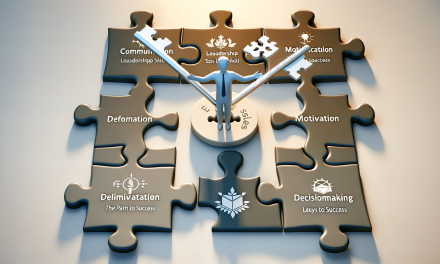Table of Contents
- Introduction
- Defining Competitive Advantage
- The Importance of Strategy Building
- Key Elements of Strategy Building
- Sustaining Competitive Advantage
- Challenges in Sustaining Advantage
- Strategies for Sustainability
- FAQs
- Conclusion
Introduction
In today’s fast-paced business environment, the quest for a competitive edge never truly ends. Companies find themselves continuously striving to differentiate themselves from the competition. Consequently, successful businesses must prioritize strategy-building and sustaining competitive advantage if they wish to thrive and grow. This article will explore various aspects of strategy-building, highlight its importance, discuss how to sustain an advantage, and provide valuable insights for business leaders.
Defining Competitive Advantage
Before diving deeper, let’s define what we mean by competitive advantage. Essentially, it refers to the attributes or conditions that allow an organization to perform better than its competitors. Companies usually achieve this through cost leadership, product differentiation, or niche focus. For example, a technology firm may have a competitive advantage due to its innovative capabilities, while a retail chain could excel in efficiency and low pricing.
The Three Main Types of Competitive Advantage
To understand competitive advantage better, it is essential to consider the three primary types:
- Cost Leadership: Companies that maintain lower operational costs can offer competitive pricing.
- Differentiation: Businesses can create unique products or services that stand out in the market.
- Niche Focus: Organizations can target specific markets and serve them exceptionally well.
The Importance of Strategy Building
Building a robust strategy is crucial for any organization looking to establish or maintain a competitive edge. A well-crafted strategy serves as a roadmap, guiding decisions and actions towards achieving set goals. Moreover, it allows businesses to be proactive in their approach to market dynamics instead of merely reactive.
Aligning Resources and Goals
A strong strategy helps align resources effectively with organizational goals. By clearly defining objectives, businesses can ensure every team member works towards a common target. For that reason, developing a coherent strategy makes allocating resources more efficient.
Anticipating Market Changes
Market conditions are ever-changing, and having an effective strategy enables organizations to adapt quickly. By staying ahead of trends and recognizing shifts in consumer behavior, businesses can pivot their focus when necessary, preventing them from falling behind.
Creating a Competitive Culture
Lastly, a solid strategy fosters a culture of competitiveness and innovation within an organization. When employees understand the overall goals and the importance of their contributions, they are more likely to adopt a proactive mindset. Consequently, a strong competitive culture encourages teamwork and collaboration, leading to greater overall success.
Key Elements of Strategy Building
While the components of effective strategy building can vary between organizations, several key elements persist in their relevance across sectors:
1. Vision and Mission Statements
Having clear vision and mission statements helps communicate the core purpose and aspirations of the organization. These statements provide context and direction, enabling employees to align their efforts accordingly.
2. Comprehensive Market Analysis
A thorough market analysis is essential in understanding competitors, customers, and overall market trends. Gaining insight into strengths, weaknesses, opportunities, and threats (SWOT analysis) enriches the strategy-building process.
3. Setting Specific Goals
Clear, measurable goals allow businesses to gauge progress and adjust their strategies as needed. SMART (Specific, Measurable, Achievable, Relevant, Time-bound) goals create an actionable framework for success.
4. Resource Allocation
Determining how to allocate resources effectively contributes to the likelihood of reaching set goals. This includes financial, human, and technological resources, ensuring businesses make decisions that support their strategic objectives.
5. Implementation Plans
No strategy is effective without a detailed implementation plan. Breaking down large goals into smaller tasks helps teams stay organized and accountable. Additionally, this creates opportunities for tracking progress and making timely adjustments.
Sustaining Competitive Advantage
Once a competitive advantage is established, the real challenge begins—sustaining it. Businesses must continually innovate and adapt in order to maintain their edge in an ever-evolving marketplace.
Adapting to Change
Organizations that resist change risk losing their competitive advantage. It is crucial to foster a mindset of adaptability within the company culture. This means being open to new ideas, technologies, and market demands to refine strategies continuously.
Investing in Innovation
Investing in research and development is another key to sustaining competitive advantage. Innovation drives differentiation; companies can create and maintain unique offerings, ensuring that competitors cannot easily replicate their success.
Building Strong Customer Relationships
Customer loyalty is an invaluable asset. By focusing on building genuine relationships with customers, organizations can create a solid foundation for sustaining their competitive advantage. Providing excellent customer service and addressing consumer needs securely helps foster brand loyalty.
Challenges in Sustaining Advantage
While the prospect of sustaining a competitive advantage is exciting, it is not void of challenges. Recognizing and addressing these potential roadblocks is vital for long-term success.
1. Increasing Competition
As markets evolve, so too do the competitive landscapes. New entrants may disrupt existing dynamics, making it necessary for established businesses to reassess their strategies regularly.
2. Rapid Technological Advancements
Technology changes and advancements can quickly shift the competitive advantage. Organizations must stay informed about emerging technologies to leverage their potential, ensuring they do not fall behind.
3. Changing Consumer Preferences
Consumer preferences are subject to change based on various factors, including trends, cultural shifts, and technological innovations. Organizations need to establish methods for proactively identifying and responding to these changes.
Strategies for Sustainability
To effectively sustain a competitive advantage, consider implementing the following strategies:
1. Continuous Learning and Development
Encouraging a culture of continuous learning enables employees to enhance their skills and adapt to changing market conditions. Training programs, workshops, and seminars can foster knowledge retention and innovation. Check out the Strategy-Building & Sustaining Competitive Advantage Course for more insights on this.
2. Monitoring Competitive Landscape
Regularly assessing competitors and market trends allows organizations to navigate changes adeptly. Strategic intelligence can provide actionable insights that facilitate decision-making and strategy refinement.
3. Fostering Collaboration and Teamwork
Promoting a collaborative workplace culture can yield innovative ideas and unique solutions to challenges. When teams can share thoughts freely and work together, organizations create a fertile ground for sustained growth.
4. Empowering Leaders
Effective leadership is essential for guiding organizations through turbulent times. By empowering leaders with the right tools and knowledge, organizations can ensure clear communication and strategic alignment among all team members. Explore these resources on leadership: Mastering Team Leadership and Management Skills, Unlocking Leadership Potential, Achieving Excellence Strategies for Management Motivation, Unlocking the Secrets of Exceptional Leadership, Leadership Masterclass: Mastering Business Management Skills.
FAQs
How can I begin building a competitive advantage for my business?
Begin by assessing your company’s strengths and weaknesses, conducting market research, and defining your value proposition. From there, develop a clear strategy aligned with your organizational goals.
What are some quick tips for sustaining a competitive edge?
Stay adaptable to change, invest in innovation, build strong customer relationships, and continually monitor your competitors and the market.
What is the role of leadership in sustaining competitive advantage?
Leadership plays a critical role in guiding an organization towards its strategic goals, fostering a culture of innovation, and ensuring effective communication throughout the team.
Conclusion
In summary, building and sustaining competitive advantage remains a challenging yet rewarding endeavor for businesses. By understanding the significance of strategy formulation and embracing the inherent challenges, organizations can position themselves for long-term success. Investing in leadership development, fostering teamwork, and continuously learning will ultimately lead to a more substantial competitive edge in the marketplace. As you embark on your strategy-building journey, remember that keeping pace with change, prioritizing innovation, and building customer loyalty is fundamental to sustaining that advantage in today’s dynamic business world.





